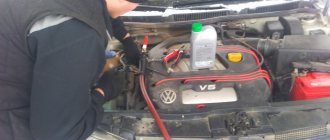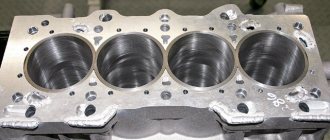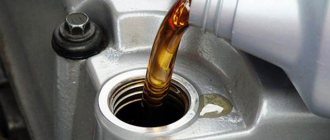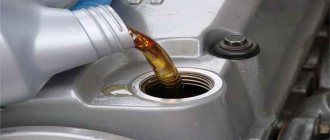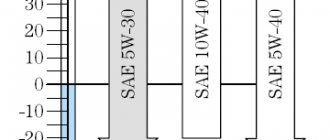Below you will find information on a complete list of original Motorcraft fluids, as well as possible replacements.
Thanks are expressed to (def7 FORD-TRACKS-CLUB) for their invaluable assistance in compiling the material.
“In brief, the ATF specifications (without the important prefixes ESP WSP, WSA, WSS): M2C166H - minimum specification for our automatic transmissions and power steering M2C185A - recommended MERCON for automatic transmissions and power steering M2C195A - Mercon (and later Mercon V) with additional anti-friction additives for power steering M2C202B — Mercon V (first generation) for automatic transmission and power steering M2C919-E — Mercon V second generation, Mercon compatible) for automatic transmission and power steering
1) Instead of the XT-2-QDX (and the Canadian CXT2LM12) "Mercon" and XT-5-QM (and the Canadian CXT5LM12) "Mercon V for Automatic Transmission and Power Steering Fluid" with the Mercon V/Dexron III specification, the XT-5- is produced QMC "Mercon V for Automatic Transmission and Power Steering Fluid Mercon compatible". The Dexron III specification has disappeared, but an unambiguous link about compatibility with Mercon has appeared.
2) In addition to semi-synthetic Mercon V, there is sometimes a similar semi-synthetic Synthetic blend Mercon V from another OEM. It is recommended for some sports US Fords, but is currently not imported into the Russian Federation.
3) Although Mercon V can also be filled into the power steering, there is also a special fluid for power steering Motorcraft XL-14 (Mercon V) in 340 ml canisters, which replaced Motorcraft XL-9 = F7AZ-3F823-BA. Both fluids meet specification WSA-M2C-195-A (www.chrysanindustries.com/pdf…s/ford195a.pdf).
4) Fluid according to the ESP-M2C166H specification is still produced (this is historically the predecessor of the Mercon specification, specially created for Ford automatic transmissions), but it is NOW recommended only for transfer cases of individual cars, not recommended for automatic transmissions (due to the addition of friction modifiers required in handout).
5) Anyone who stubbornly does not want to switch to Mercon V would recommend this (OEM Motorcraft USA) inexpensive liquid from Kendall with a mineral base (and pour point -40): www.conocophillipslubricants...0TDS%20Web.pdf This ATF is available in Moscow, (FORD-TRACKS-CLUB forum members) we will always help! At the same time, the mineral base and additive package will be maximally compatible with what is splashing around in your CD4E automatic transmission and power steering, and for TOP-UP this will be the best option. Although, when replacing (full or three times partial), Mercon V (Mercon compatible) will still be better...
6. In both the USA and Europe, the latest models began to be fueled with new ATFs, for example Mercon LV (low viscosity, WSS-M2C938-A and XT-10-QLV, 1496116) and Mercon SP (later Mercon LV was recommended instead)— I'll write about them next time. The main thing is that they cannot be used instead of Mercon V due to their lower viscosity!
7. About non-original Mercon V fluids. The additive package, officially licensed to the Mercon V specification, is made by ConocoPhillips (and closely related Petro-canada in Canada) and Exxon-Mobil. Many other manufacturers, without receiving official approval for Mercon V, only state “meets the requirements.” So you can safely use ATF from Motorcraft (as well as ConocoPhillips in the USA and Petro-Canada in Canada), Mobil and some other officially approved manufacturers (Comma, Pennzoil, Chevron, Shell, Ravenol...)
News from Europe
Also, the Mercon V specification has changed to Mercon V Mercon compatible, so there should now be no problems with mixing ATF.
1) For automatic transmissions, instead of Mercon (3504983, FORD E-AT/PS 1L 5014519, 5L 5014520 according to specification WSS-M2C-166H) manufactured by Mobil and Mercon V (Ford E-M5 8000045 according to specification WSS-M2C202B) also manufactured by Mobil universal FORD DP-5M 1565889-1l and 1565890-5l (WSS-M2C919E).
2) For power steering, the general specification WSS-M2C195A is retained, but instead of Mercon (4571525 and 1087900) manufactured by Mobil and Mercon V (Ford ER 8000047, also manufactured by Mobil). Now comes the universal number FORD IW 1590988 (black US canisters, I wonder who makes it, most likely it is the above-mentioned US XL-14 at the same price).
3. Green ATF WSS-M2C204-A DP-PS 1384110 (aka Pentosin CHF11S, CHF202) for electric power steering (electrically-hydraulic power steering), although it has better low-temperature and anti-wear properties, is not suitable for power steering due to its lower viscosity.
The latest 2010 revision of the ATF specification for power steering WSA-M2C-195-A states that it will no longer be developed and is overlapped by Mercon LV, aka WSS-M2C-938-A ( www.chrysanindustries.com/pdf...s/ford938a. pdf) and WSS-M2C204-A2. In particular, some Fords are already filled with green power steering fluid (manufactured by Pentosin) Information from www.chrysanindustries.com/aut…ll-fluids.html: FORD WSA M2C195 A:2010 Engineering Material Specification - Fluid, Power Steering General Product Information Status: Superseded Superseded By: FORD WSS M2C204 A2:2003 FORD WSS M2C938 A:2007 Supersedes: FORD WSA M2C195 A:2004 FORD ESP M2C138 CJ:200
How to properly change power steering fluid in a Ford Focus?
Hydraulic fluid is a technological substance, red, yellow or green, with the help of which resistance is exerted from the pump to the hydraulic cylinder, creating easier steering. In order for such a design to work properly, the system requires periodic diagnostics and maintenance, including oil changes.
According to technical regulations, the Ford Focus manufacturer fills hydraulic consumables into the vehicle at the factory. During the entire period of operation, the car does not need to be replaced. However, this rule is in most cases erroneous. As a result of long-term operation, the steering rack, as well as the fluid that lubricates the parts, can wear out and become unusable. In this case, it is necessary to replace the fluid in the power steering on a Ford Focus.
Every driver needs to periodically check the quantity and quality of the oil in the power steering reservoir. The required hydraulic mixture should vary within the MAX and MIN marks. The expansion tank is located in the engine compartment, near the engine.
To determine the quality of the hydraulic mixture, it is necessary to pour a small amount of the contents from the reservoir onto a white sheet of paper. This can be done using a medical syringe. If the oil has acquired an uncharacteristic color or odor, or foams, it needs to be replaced urgently.
Signs indicating the need to change the hydraulic oil:
- When turning the wheels, uncharacteristic sounds, creaking or vibration (shocks) are made;
- The steering wheel rotates with effort;
- Insufficient oil level in the system;
- The presence of foreign substances in the solution (foam, sediment, chips);
- Changing the color of the mixture;
- Presence of a burning smell.
Mechanics recommend replacing hydraulic fluid every 3 years, or after 100,000 km.
Preparation for replacement, list of necessary tools
When choosing oil, you are guided by two types of liquid - red or green. There is also a neutral yellow solution - the most suitable for pouring into a Ford Focus car.
Popular brands of hydraulic mixture for Ford Focus cars:
- Ford WSA/M2C938/A - red liquid. The cost of 1 liter is 1400 rubles;
- Power steering fluid for Ford M2C204/A2 USA. Green solution, costing 600 rubles;
- The cheapest but no less high-quality analogues are Motorcraft Merkom LV and SWAG Febi (up to 600 rubles per 1 liter).
Before adding oil, you must read the instructions from the manufacturer.
List of tools for replacing power steering fluid on a Ford Focus:
- jack;
- medical syringe with maximum volume;
- rubber tube;
- empty container for collecting oil (1.5 - 2 l).
Filling with new power steering fluid
The process of changing oil in the power steering system consists of three stages:
- collecting old fluid;
- pouring a new one;
- checking system operation.
All work must be carried out with the engine turned off.
Procedure for replacing power steering fluid:
- Initially, you need to raise the car so that no pressure is applied to the steering wheel. This can be done using a jack;
- Open the expansion tank and extract the liquid with a syringe with a tube;
- Disconnect the pipes and pour the remaining mixture into the container;
- Fill in new solution to the maximum mark;
- Turn the steering wheel several times until it stops. This way the oil will be distributed evenly throughout the power steering system;
- Add mixture (if necessary).
Power steering fluid FORD DP-PS green, 1 l / 1781003
Original power steering fluid FORD DP-PS green, 1 l / 1781003 - original synthetic hydraulic oil, which is intended for universal use. Serves as an anti-corrosion and lubricant. The oil was developed taking into account all Ford requirements. This product should only be used in Ford vehicles. It contains additives such as viscosity stabilizers, acidity stabilizers; anti-corrosion, anti-foam, coloring additives; additives that reduce friction and protect rubber parts, etc. The product guarantees excellent operation of all hydraulic systems: power steering, convertible roof drive and other hydraulic systems.
FORD WSS-M2-C204-A2.
Use in accordance with the vehicle manufacturer's recommendations.
Hydraulic power steering (power steering) is a complex hydraulic system to facilitate vehicle control while maintaining sufficient steering feedback. One of the main components of this system is hydraulic fluid, which is necessary for the normal operation of the power steering pump. The need to top up this fluid occurs quite rarely, but it still needs to be topped up periodically to keep the entire power steering system in good condition, especially since the price of Ford power steering fluids in Moscow is now quite low and varies in the range from 500 to 1500 rubles per 1 liter .
When should you change Ford power steering fluid?
The hydraulic fluid needs to be changed if its level has dropped below the minimum mark, or if it is no longer clean enough. You need to check the level and cleanliness of the power steering fluid once every six months, or whenever there is any deterioration in controllability. The hydraulic fluid level is checked by special marks on the reservoir and by marks on the dipstick, which is located on the reservoir cover. As for the purity of the hydraulic fluid, it is determined purely visually.
How to choose power steering fluid for your car?
There are two types of hydraulic fluids: mineral and synthetic. The vast majority of cars require mineral fluid. Synthetics are only suitable for some cars with automatic transmission. It is worth remembering that if the car’s instructions do not specifically state what kind of hydraulic fluid should be poured, then only mineral fluids should be used.
Liquids are also classified by color: red, yellow and green.
If you need to add power steering fluid, it is best to use the same fluid that you have already filled. If you can’t find the same liquid, then you should use two simple rules: 1. Never mix mineral water and synthetics. 2. Yellow and red power steering fluids can be mixed with each other, but green fluids can only be mixed with green ones.
Which one to pour?
Power steering fluid for Ford is a synthetic material that ensures stable and safe operation of the unit. The consumable substance can perform its functions at temperatures from -40 to +120 degrees. If we talk about a specific brand of steering oil for Ford Focus 2, then you can use several options: either Ford WSA/M2C195/A, or Ravenol-PSF. If it is not possible to purchase this oil, then you can buy another, but analyze the requirements of the car manufacturer and the composition of the consumable material.
Liquid WSA/M2C195/A
Stages of work
To replace the power steering lubricant, do the following:
- Drain the used liquid. Stop the engine and open the fluid expansion tank. Unscrew the bolts that secure it and disconnect the pipes connected to it. This will lead to consumables leaking out, so place a container in advance (maybe a cut-off bottle) with a volume of at least two liters.
- We connect the clamp. Using long-end pliers, hook the clamp from the return line and move it to the side. The clamp is connected to the expansion tank with consumables.
- We provide access. Disconnect the return line pipe, and then install the fitting from a previously prepared hose. Instead of a pipe, a tube with a plug is used.
- We fill in new material. Open the reservoir cap and fill it with new lubricant. Consider some points here. While you are adding lubricant, your assistant should start the power unit. When filling, monitor the color of the consumable material, which is pumped out of the reservoir under the influence of pressure in the pump. When fresh lubricant comes out of the tank, differing from the used one in color and smell, the engine must be stopped. When filling, do not allow air to enter the system, this will lead to the formation of plugs that will subsequently have to be removed.
- The final stage. Top up to the maximum level, then start the engine and let it run. Make a test drive and check the lubricant level again. Add fluid to the system if necessary. All components are assembled in reverse order.
Photos of replacing consumables are shown below.
1. Drain the lubricant from the reservoir and turn off the return line 2. Fill in new oil into the hydraulic steering system
When replacing lubricant, do not allow it to come into contact with the timing belt, otherwise it will cause rapid wear.
Application area
The Ford Motocraft Mercon 5 composition is intended for use in automatic transmissions from FORD, Lincoln, Mercury and other manufacturers installed on these vehicles. The oil is suitable for cars, trucks, passenger and highly specialized vehicles, regardless of the area of application and type of fuel consumed. Also, the lubricant retains its positive properties when poured into power steering and electronically controlled gearboxes.
Users note the suitability of the fluid for filling into gearboxes of other concerns and companies, subject to the necessary approvals.
Ford specifications and approvals for power steering fluids
Like any other operating fluid, power steering oil is made either on a mineral, synthetic or semi-synthetic basis. What is poured into the power steering from the assembly line depends on the plant where the car was assembled. The color of the liquid in this case will be the main beacon for choosing oil for topping up and replacing, but not the manufacturer of the liquid. The company has established the following compliance for all liquid manufacturers:
- for red liquid - WSA-M2C-195-A;
Power steering oil WSA-M2C-195-A-1
- for green oils - WSS-M2C-204-A2;
Power steering oil WSS-M2C204-A2
- and another approval for red oils - WSS-M2C-938-A .
In addition to these liquids, yellow is also found. As a rule, it is filled or was filled at the plant in Vsevolozhsk. Focuses assembled in Cologne are filled with red liquid, while cars assembled in Spain are filled with green liquid. This is such a mess.
How to check correctly?
If you believe the service manual, then power steering fluid for Ford Focus 3 or 2 is filled for the entire service life of the vehicle. In fact, the situation is somewhat different. While using the vehicle, the power steering device on the second or third Focus may break down. Some unit failures require replacement of consumables. In practice, the oil level should always be checked.
The hydraulic booster can hum for various reasons. If you notice a leak, a buzzing sound when turning the steering wheel to Focus one or two, as well as a change in the color of the oil or deterioration in the operation of the steering column, first check the fluid.
If the humming does not stop, and there is less oil in the power steering reservoir than it should be, the system needs to be checked for leaks:
- Turn off the engine and wait until it cools down.
- Use a rag to wipe all elements of the steering system.
- Then check the power steering reservoir directly, if there is a need to add oil, do so.
- After this, start the engine and turn the steering wheel in different directions. This way you can identify the location of the leak.
Power steering expansion tank in Focus
Remember that in Ford Focus 1 or another model you must use the oil recommended by the manufacturer. And if you add fluid to the system, it must match the one that is already in use. In some cases, the power steering hums not because of a lack of oil, but as a result of the failure of various components, for example, a pressure sensor or pump. If the problem is the latter, then only repairing the power steering pump will fix it.
Please note that consumable level diagnostics are carried out exclusively on a flat surface. You can see MIN and MAX marks on the tank, indicating the minimum or maximum level. The level of the substance should be approximately in the middle with the engine turned off. When the power unit is started, the level may rise to the maximum, this is normal. But if the consumable has dropped to the MIN mark, this indicates the need to add a substance (the author of the video is the Made in the Garage channel).
How to spot a fake
You can identify the original FORD Motorcraft Mercon V ATF by the following criteria.
- The original packaging is made of high-quality plastic; the material does not harden in winter and can withstand mechanical loads without deformation.
- The canister lid has a protective ring. The element comes off when first opened and remains on the filler neck.
- Labels are printed on factory machines. The manufacturing procedure eliminates the presence of grammatical errors, blots or typos. Also, a counterfeit can be revealed by skew or the presence of large grains of paint - upon closer examination, the font is even and clear.
- The label contains a complete list of information about the manufacturer, product, production date and location of the production facility. The information is complete and coincides with the display on the company’s official website.


